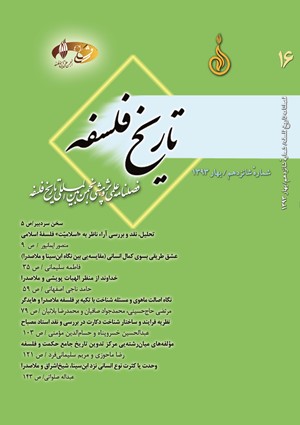وحدت يا كثرت نوع انساني نزد ابنسينا، شيخاشراق و ملاصدرا
محورهای موضوعی : ریشهشناسی واژگان (اتیمولوژی) فلسفی
1 - دانشگاه تربيت دبير شهيد رجايي
کلید واژه: کثرت نوعي انسان وحدت نوعي متواطي وحدت نوعي مشکک زيست¬, نوعهاي انساني ابن سينا سهروردي ملاصدرا ,
چکیده مقاله :
وحدت يا کثرت نوعي انسان يکي از مسائلي بوده که غالباً در سنت فلسفة حاشيه و بعنوان پيش فرض مطرح بوده است و بيشينة فيلسوفان مسلمان، از وحدت نوعي انسان دفاع ميکردهاند. اما مخالفان وحدت نوعي، با صورتي برهاني به طرح کثرت نوعي انسان پرداختند. البته در آثار موافقان وحدت نوعي از جمله ابنسينا شواهدي دال بر کثرت نوعي انسان يافت ميشود. در اين جستار منحني تطورات نابرابري و کثرت نوعي انسان با محوريت متفکران برجسته و مؤثري چون ابنسينا، سهروردي و ملاصدرا مورد بحث و بررسي قرار ميگيرد. منحني کثرت نوعي در تفکر فلسفي و کلامي جهان اسلام، دستخوش نوساناتي بوده است، اما سير پيدايي آن را ميتوان چنين فهرست کرد: کثرت نوعي انسان در حد شواهد نزد ابنسينا، وحدت نوعي مشکک (انسانهاي نابرابرِ برابر) نزد سهروردي و سه مدلِ وحدت نوعي مشكَك وجودي صرف، وحدت نوعي مشکک ماهوي در پي وحدت نوعي مشكَك وجودي و کثرت نوعي مشکک ماهوي در پي وحدت نوعي مشكَك وجودي نزد ملاصدرا؛ با اين توضيح که هريک از مدلهاي سه گانة صدرايي به دو صورتِ پيشين و پسين مطرح ميباشد. کثرت نوعي صدرايي بدليل پشتيباني توسط مباني، تنوع مدلها و اشتمال آن بر کثرت نوعي پيشين و پسين، فضاي دگرديسيشده يي از نابرابري انسانها را پديد آورد که نگارنده براي نشان دادن تفاوت جوهري آن با کثرت نوعي انساني پيش از ملاصدرا، از آن به زيست نوعهاي انساني ياد کرده است.
The specific unity or plurality of man is one of the problems that has often remained a marginal one and taken for granted as a presupposition in traditional philosophy. In the past, most Muslim philosophers defended the specific unity of man. However, the opponents of this idea posed the specific plurality of man using a demonstrative method. Of course, in the works of some of the advocates of the specific unity of man, such as Ibn Sina, there are some pieces of evidence attesting to this theory. This paper discusses and examines the curve of the evolution of the specific plurality and inequality of man with reference to some prominent and influential thinkers such as Ibn Sina, Suhrawardi, and Mulla Sadra. This curve has undergone some fluctuations in the philosophical and kalami schools of the world of Islam. Nevertheless, the process of its development entails the following theories: specific plurality of man at the level of evidence by Ibn Sina, graded specific unity (unequal equal human beings) by Suhrawardi, and three models of purely ontological and graded specific unity, the quiddative graded specific unity seeking ontological graded specific unity, and quiddative graded specific plurality seeking ontological graded specific unity by Mulla Sadra. It is noted that each of the three-fold Sadrian models exists in two apriori and aposteriori forms. The Sadrian specific plurality, because of its relying on solid supporting principles, having a variety of models, and entailing apriori and aposteriori forms of specific plurality, created a transformed atmosphere of inequality of human beings. In order to demonstrate the substantial difference between this type of plurality and the specific plurality of human beings before Mulla Sadra, the writer has referred to the former as human life-specific model.
